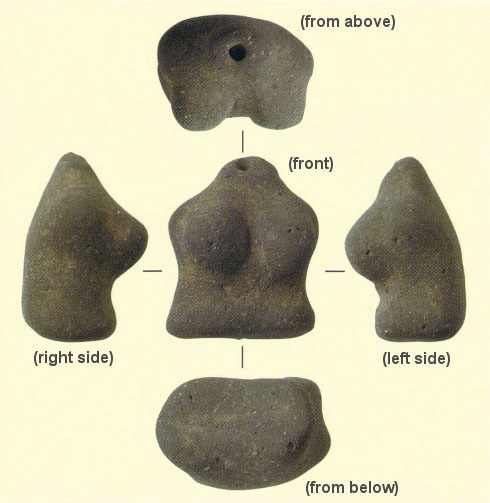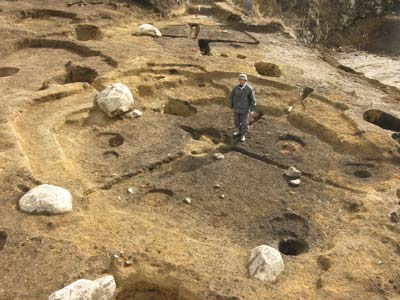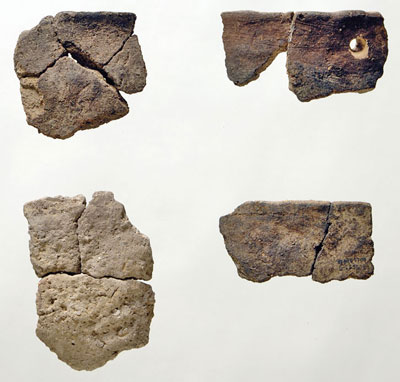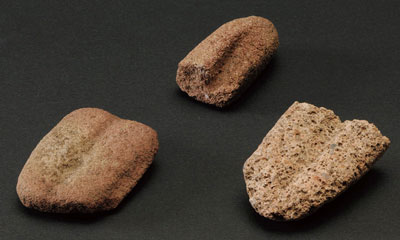Aidani Kumahara:
One of the oldest clay figurines for Japan, with well developed breasts, is recovered from a large pit-structure without parallel in its time.

 Clay figurine
Clay figurineIts base finished as a flat surface, it stands upright with a slightly forward lean. The top is perforated with a hole 3 mm in diameter and 2 cm deep. Height: 3.2 cm; width: 2.7 cm.


Pit-structure that yielded the clay figurine (from the north)
The clay figurine was found near the floor surface. About 8 m in diameter, it is ringed with a terrace-shaped elevation. Large boulders are exposed, and it appears the structure was built by digging down around these items rather than removing them.
Aidani Kumahara Site, Higashiōmi City, Shiga Prefecture
An Incipient Jōmon settlement on the eastern side of Lake Biwa
Aidani Kumahara is a settlement site spanning the latter half of the Incipient to the Final Jōmon periods (ca 13,000 - 3,000 BP), located in the foothills of the Suzuka mountains on the eastern side of Lake Biwa. In excavations beginning in 2009, five pit-structures from the latter half of the Incipient Jōmon were found, and from one of these a clay figurine ranking among the oldest of these items in the country was recovered.
When radiocarbon dating was done with carbonized material adhering to the surface of pottery recovered from the pit-structure, it was seen to be approximately 13,000 years old.
Early clay figurines concentrate in central Honshu
The figurine is small enough to fit in the palm of hand, and models only the torso, but from the well developed breasts and constricted waist it is seen to represent a woman.
As a clay figurine dating back to the Incipient Jōmon, at present there is an item recovered at the Kayumi Ijiri site in Mie prefecture, and another from the start of the succeeding Early Jōmon has also been found in the foothills of the Suzuka mountains (at the Ōhana site in Mie prefecture).
That every example from the initial phase of clay figurines comes from the central part of Honshu, and they are moreover found at foothill sites, perhaps provides clues for considering the circumstances under which these items were first devised.
Large pit-structures
The five pit-structures found at the site were larger than those discovered thus far throughout the country from the same period, being 6 - 8 m in diameter (28.1 - 49.7 m2) and with the floor approximately 1 m below the ground surface for deep examples. The contents and shapes of the pottery, stone tools, and other artifacts from the five structures are similar, and the group of buildings is thought to have been built within a very short span of time.
In order to erect this type of large structure a considerable amount of labor is needed, and there also must have been a reason for building one. This indicates a settled way of life, surviving through group effort to utilize the resources of hills and rivers within a somewhat limited area of livelihood, differing from the small groups (consisting perhaps of families) which until then led a nomadic life while hunting. These large pit-structures and the clay figurine may be regarded as indications of this transition in lifestyle.
In particular, was the clay figurine left inside one of these structures perhaps made in prayer for a stable livelihood? (Matsumuro Takaki and Shigeta Tsutomu)
Clay figurines -- modeling the human form
The clay figurine discovered at the Aidani Kumahara site, a female figure made approximately 13,000 years ago with an unexpectedly high degree of realism, prompted tremendous response. Truly a "Venus." It was not simply the age, but perhaps also reverence for the keenly observant eye and expressive skill of the artist who made it, that was so deeply moving.
As expressions of the human form there are stone figurines from the Upper Paleolithic period (ca 20,000 - 15,000 BP). A stone figurine recovered from the Kamikuroiwa rock shelter, a Historic Site in Ehime prefecture, has a human form expressed by incising (drawing) hair of the head and breasts on the surface of a flat stone, but there is a large gap between this and the clay figurine in terms of form as well as material.
But if we widen the scope to include the Eurasian continent, realistically modeled female figures from the Paleolithic period are found over a wide area stretching from Eastern Europe to Siberia. Did this custom of modeling the human form arise on the Eurasian continent, with the similar practice of making human figures at the continentfs eastern edge, in the Japanese archipelago, arriving through diffusion, or did the same type of idea come to be held despite the separation in space?
Among the many clay figurines of the Jōmon period in which the body is deformed, the item from the Aidani Kumahara Site has drawn attention for its realistic expression. As no examples from the periods both preceding and following are as realistic, it is an extremely rare case. If the environment surrounding the site, or the livelihood and so forth are compared with those of examples from the Eurasian continent, a lead might be obtained for clarifying the circumstances from which this clay figurine was produced. (Matsumuro Takaki and Shigeta Tsutomu)
Adapted from Hakkutsu sareta Nihon rettō 2011 [Excavations in the Japanese Archipelago, 2011] (Bunkachō [Agency for Cultural Affairs], ed., Asahi Shimbun Publications, 2011).
Photos courtesy of Shiga Prefectural Board of Education



